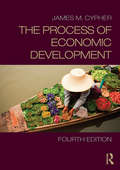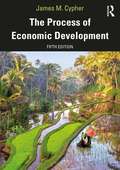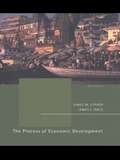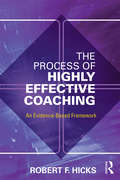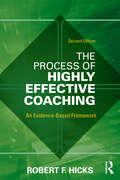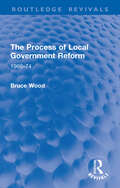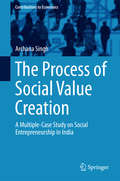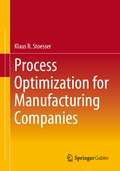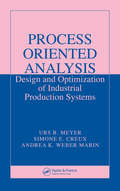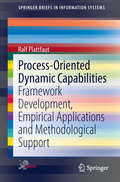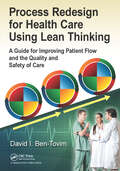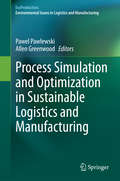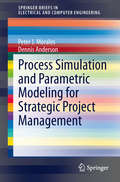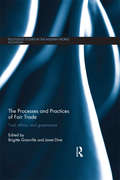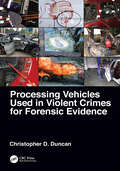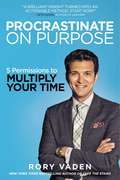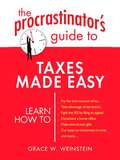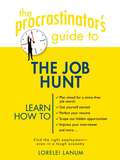- Table View
- List View
The Process of Economic Development
by James CypherThe fourth edition of The Process of Economic Development offers a thorough and up-to-date treatment of development economics. This landmark text will continue to be an invaluable resource for students, teachers and researchers in the fields of development economics and development studies. The new edition has been revised and updated throughout, reflecting the most recent developments in research and incorporating the latest empirical data, as well as key theoretical advances. The period since the publication of the third edition of The Process of Economic Development has been a time of immense change in the developing world. The period has seen huge economic growth in China, economic restructuring in India and the continuing impact of environmental issues such as climate change. The fourth edition reflects these developments, as well as including numerous case studies and new material on the following: transnational corporations and labor in export processing zones industrial policy and structural change gender inequality, income distribution and development progress towards the Millennium Development Goals technology and national innovation systems aid and the least developed nations the post debt crisis era and debt relief for Africa. Cypher's comprehensive account remains the development economics text par excellence, as it takes a much more practical, hands-on view of the issues facing developing countries than other, overly mathematical texts. This book is unique in its scope and in the detailed attention it gives to the historical contexts that have influenced progress toward development. It is accessibly written both for students of economics and for those with an interest in the many aspects of development studies.
The Process of Economic Development: Theory, Institutions, Applications And Evidence
by James M. CypherThe fifth edition of The Process of Economic Development offers a thorough and up-to-date treatment of development economics. It has been extensively revised throughout, reflecting the most recent developments in research and incorporating the latest empirical data, as well as key theoretical advances and many new topics. The world has seen vast economic growth in China, economic transformation in India, new challenges in Latin America, rapid economic progress in Southeast Asia, and the deepening impact of environmental issues such as climate change. This new edition addresses all these critical issues as well as the pivotal role of the state, where China’s capacity is contrasted with that of African states. Transnational corporations’ reliance on low-wage manufacturing and labor arbitrage is featured in the book. Agricultural policy—extensively explored—remains crucial, as does the promotion of industrialization. This fifth edition offers a ‘state-of-the-art’ analysis of these essential themes and many others. Numerous case studies and issue focuses have been integrated with sundry central topics. Neoclassical theories and applications, including a timely exploration of behavioral economics, are both rigorously and accessibly explicated. Cypher’s comprehensive account remains the development economics text par excellence, as it takes a much more practical, hands-on view of the issues facing the developing countries than other, overly mathematical texts. This book is unique in its scope and in the detailed attention it gives to a vast range of ideas, including pioneering developmentalist and heterodox formulations. Distinct institutional structures are examined within their historical contexts. This landmark text will continue to be an invaluable resource for students, teachers, and researchers in the fields of development economics and development studies.
The Process of Economic Development: Theory, Institutions, Applications and Evidence
by James L. Dietz James M. CypherDrawing together recent changes in the debates with the history of the subject, The Process of Economic Development is a textbook with a story to tell. A discussion of recent events is integral to the book, with discussions ranging from* the environment* the debt crisis* export led industrialization* import substitution industrialization* growth theory and technological capabilityThe book has an accessible style and format. Plentiful diagrams, boxed summaries, and end of chapter questions help the reader to grasp many-faceted topics.Coverage includes Latin America, Africa and Asia giving students a uniquely balanced world picture.
The Process of Excelling: The Practical How-to Guide for Managers and Supervisors
by Roger E. HermanRoger E. Herman is a nationally recognized speaker, author, trainer, and consultant. With over two decades of experience managing a variety of public, private, and nonprofit organizations, he's "been there". Roger is known for his practical, down-to-earth approach to managing. Though he has taught management at the college level, his focus goes far beyond theoretical concepts. Through his speeches, seminars, workshops, and articles, he shares sensible ideas and techniques that work.
Process of Going Public in the United States
by Gregory S. MillerSummarizes the process of going public: the steps for SEC approval, the role of the SEC, and the roles of major players such as underwriters and printers.
The Process of Highly Effective Coaching: An Evidence-Based Framework
by Robert F. HicksThe Process of Highly Effective Coaching offers a unique blend of theory and practical methods for conducting effective coaching conversations. It provides an umbrella under which all of the major conceptual models for helping people change can not only coexist but work together. In addition to using this integrative approach, The Process of Highly Effective Coaching presents a framework for conducting coaching conversations and for relating the coaching process to the coaching competencies defined by the International Coach Federation, the largest coach-credentialing organization in the world.
The Process of Highly Effective Coaching: An Evidence-Based Framework
by Robert F. HicksThe Process of Highly Effective Coaching, 2nd edition, offers a unique blend of theory and practical methods for conducting effective coaching conversations. The book presents a framework for navigating a conversation’s dynamic flow, enabling the practitioner to assimilate information and exhibit the agility of master-level coaches. Additionally, the framework synergistically incorporates the major evidence-based models for achieving client-driven outcomes. This second edition contains fresh content that ties the Foursquare Coaching Framework to the latest information from neuropsychology, leadership, and organizational change.
The Process of Local Government Reform: 1966–74 (Routledge Revivals)
by Bruce WoodOriginally published in 1976, this book examines how and why local government reforms came about and what influences, pressures and compromises were involved. At the time of publication it provided the most detailed account so far of the process by which the 1972 Local Government Act was approved by Parliament following the Redcliffe-Maud report and two White Papers. At the same time, as a case study of the British policy-making process, it examines more general issues about the political manoeuvring of groups in conflict, the concept of ‘government by Commission’ and the range of strategies which were open to Government decision makers. The book will prove essential reading for students of the history of British Government policy-making and political processes, and of administrative change and innovation.
The Process of Social Value Creation: A Multiple-Case Study on Social Entrepreneurship in India (Contributions to Economics)
by Archana SinghThis book discusses social entrepreneurship, especially in context of India. It focuses on understanding the whole process of social value creation, i.e. social entrepreneurship - opportunity identification, resource mobilisation, social value, capabilities of social entrepreneurs and innovation in three different types of social enterprises – (i) non-profit or charitable ones; (ii) non-profit social enterprise, sustainable with the combined income of grants, subsidies and own earned income; self-sustainable not-for-profit social enterprise; and hybrid social enterprise; and (iii) for-profit social enterprises. Sample cases of social entrepreneurs (Ashoka Fellows) were selected from three inter-linked sectors -- health, education and livelihood. To provide a comprehensive view, interviews were taken not only from the founders (social entrepreneurs), management personnel, and other employees, but also from the beneficiaries. The book comprises how, on the basis of cross-comparison between three types of social enterprises, several propositions and finally theoretical framework on social entrepreneurship have been developed. It proposes that social entrepreneurship can be acquired and that these social entrepreneurs can help solve the larger social problems faced both by developing and developed nations.
Process of Strategy Definition and Implementation
by Clayton M. Christensen Jeremy B. DannStrategy definition is not a short, discrete process. Rather, outside influences (market, political, technological, etc.) and the company's own resource allocation process continually reshape an organization's strategy.
Process Optimization for Manufacturing Companies
by Klaus R. StoesserErfahren Sie in diesem Buch über Prozessoptimierung für produzierende Unternehmen alles über die neue Methode LEO-3DIn seinem Buch „Prozessoptimierung für produzierende Unternehmen“ beschreibt Klaus R. Stoesser einen neuen, kombinierten Ansatz, mit dem Firmen aus dem produzierenden Gewerbe ihre Geschäftsprozesse optimieren können. Der Autor stellt hierfür Philosophien wie Lean Management, Six Sigma und SCRUM vor. Darauf aufbauend führt er seine eigens entwickelte Philosophie LEO-3D ein, welche Unternehmen vielseitige Möglichkeiten bietet.Der Inhalt im ÜberblickIm Kern geht es in Stoessers Buch über Prozessoptimierung für produzierende Unternehmen um folgende Themen:• Entwicklung der Prozessoptimierung• LEO-3D• Ausgewählte Methoden, Tools und VorgehensweisenEs vermittelt diese Ansätze, um Prozesse in Unternehmen ganzheitlich im zu verbessern und damit das Ergebnis nachhaltig zu steigern.
Process Oriented Analysis: Design and Optimization of Industrial Production Systems
by Urs B. Meyer Simone E. Creux Andrea K. Weber MarinIn modern manufacturing, it is not simply the equipment that is increasingly complex but rather the entire business system in which a company operates. Convoluted supply chains, complicated resource flows, advanced information systems: all must be taken into account when designing or reengineering a manufacturing system. Introducing a powerful yet
Process-Oriented Dynamic Capabilities
by Ralf PlattfautThis book introduces a process-oriented dynamic capability framework to study both, service innovation and Business Process Management (BPM). Results from applications in several case studies and surveys are reported. They reflect, e. g. , capability development and maturity models. Based on these findings, a method to support service innovation is introduced. This method can help organizations in developing new service business models in a more effective and efficient way. In today's networked service society, service innovation becomes increasingly important. Reasons for this development can be found in the transformation of economies and in the growing importance of product-service systems. The concept of service innovation is related to Business Process Management (BPM) and shares several important traits. They both are process-oriented dynamic capabilities to adapt (service) processes to changing environments.
Process Redesign for Health Care Using Lean Thinking: A Guide for Improving Patient Flow and the Quality and Safety of Care
by David I. Ben-TovimProcess Redesign for Health Care Using Lean Thinking is a response to a simple, but hard to answer, question and is the result of the experiences of a working doctor who was also the chief safety and quality officer of an Australian teaching hospital. At this hospital, he observed that the Emergency Department was staff by talented, well-trained, and respected doctors and nurses. The facilities were modern, and the work load unexceptional, but the department was close to melt down. Bad things were happening to patients, everyone was blaming each other, lots of things had been tried but nothing was getting better and no one could explain why. The problem was not a lack of technical knowledge or expertise, the problem was that no one stood back and said, "what’s the best way to move 200 or 300 patients a day through the complicated and varying, sequence of steps needed to sort out the many different problems that bring patients to our department?" These challenges are faced by hospitals and health services all over the world. There are difficulties with patient flow, congestion, queues, inefficient utilization of resources, problems engaging clinical staff in improvement programs, adverse incidents, and budget constraints. Lean thinking and value stream analysis gives hospitals and health services struggling with these issues the insights they need to help themselves. This book provides a method that systematically turns those insights into working programs of service and system redesign. The book is divided into two sections. The first section gives the background to the approach, and systematically works through the Process Redesign methodology, step-by-step. The second section is a series of case studies that show the methodology in action, what worked and what didn’t work. The goal of any process redesign is simple: the right care, for the right person, at the right time, in the right place, and right the first time. This book helps the people who work in hospitals and health services realize these goals by working together.
Process Simulation and Optimization in Sustainable Logistics and Manufacturing
by Pawel Pawlewski Allen GreenwoodThe aim of this book is to present qualitative aspects of logistics operations and supply chain management which help to implement the sustainable policy principles in the companies and public sector's institutions. Authors in individual chapters address the issues related to reverse network configuration, forward and reverse supply chain integration, CO2 reduction in transportation, improvement of the production operations and management of the recovery activities. Some best practices from different countries and industries are presented. This book will be valuable to both academics and practitioners wishing to deepen their knowledge in the field of logistics operations and management with regard to sustainability issues.
Process Simulation and Parametric Modeling for Strategic Project Management
by Dennis Anderson Peter J. MoralesProcess Simulation and Parametric Modeling for Strategic Project Management will offer CIOs, CTOs and Software Development Managers, IT Graduate Students an introduction to a set of technologies that will help them understand how to better plan software development projects, manage risk and have better insight into the complexities of the software development process. A novel methodology will be introduced that allows a software development manager to better plan and access risks in the early planning of a project. By providing a better model for early software development estimation and software development, managers will be better equipped to make more effective project portfolio investment choices. Moreover, the methodology will allow the software development manager to continually simulate scenarios throughout the lifecycle of the project and determine plausible alternatives before the risk becomes a reality.
The Processes and Practices of Fair Trade: Trust, Ethics and Governance (Routledge Studies In The Modern World Economy #107)
by Brigitte Granville Janet DineThis book analyzes the factors behind the recent expansion of Fairtrade and questions whether the trust given to the scheme by "ethical" shoppers is warranted. It goes about this assessment by analyzing the claim of ethical shopping and by scrutinizing the specific contribution of the Fairtrade Certification Mark to producer’s welfare. This assessment is based on information gathered in a mixture of desk-based research and fieldwork carried out in Argentina, Bolivia, Chile, Peru, Tanzania and South Africa. This book comprises separate chapters written by academics of various backgrounds, who have worked together on Fairtrade, it should however be noted that the authors do not necessarily hold a common set of views in respect to Fairtrade.
Processes and Production Methods (PPMs) in WTO Law
by Christiane R. ConradDespite a decades-long debate, starting with the 'Tuna-Dolphin' disputes of the 1990s, questions on the status of national regulatory measures linked to processes and production methods in WTO law have yet remained unsolved. Likewise, labelling requirements relating to unincorporated aspects of a product's life cycle remain strongly contested. These ongoing disputes at the WTO as well as global social and environmental challenges related to economic activities show how topical and important the search for adequate answers still is. Processes and Production Methods (PPMs) in WTO Law identifies and comprehensively analyses the key legal problems concerning such measures, setting them in the context of the current debate and its economic and regulatory background. Christiane R. Conrad develops a new approach to this debate which draws on the objectives and established economic rationales of the WTO Agreements.
Processing Vehicles Used in Violent Crimes for Forensic Evidence
by Christopher D. DuncanWhile there are numerous books on crime scene investigation and the processing of crime scenes, few focus on the processing of vehicles. Whether the crime took place in the car or the car was used to transport the suspect or victim—and, as such, is a secondary scene—investigating vehicles presents several unique challenges. Processing Vehicles Used in Violent Crimes for Forensic Evidence fills this void providing the technical instruction sorely needed in this area of crime scene investigation. The book is geared not only to investigators who process vehicles involved in general crimes but also with a specific focus on violent crimes. Coverage includes details as to how investigators should document the vehicle in a logical and methodical manner that is easily understood and replicated for various scenes. By identifying the unique challenges caused by working in the tight quarters of a vehicle—especially in photographing the vehicle, the evidence within it, and how to best find, collect, document, and preserve the evidence—the author provides a unique reference for investigators. Special attention is paid to documenting shooting incidents, the proper detailing and documentation of bullet trajectories, bloodstain documentation, and processing vehicles for other biological, impression, and physical evidence. Key Features Presents crime scene collection and preservation techniques and methodology specific to vehicle-related considerations Outlines the unique challenges, and step-by-step procedural requirements, necessary to conduct a vehicle or vehicle-related scene investigation Addresses types of various evidence for vehicles—including fingerprint, blood, DNA, bullet and casing, and fire debris—which are common primary or secondary crime scenes While the book is geared toward crime scene investigators and forensic technicians who process vehicles used in crimes, it will be an invaluable resource for criminal justice and forensic science students, attorneys, death investigators, fire investigators, accident scene investigators, and scene reconstructionists.
Procrastinate on Purpose
by Rory VadenFrom the New York Times bestselling author of Take the Stairs--a bold new way to get things done. New York Times bestselling author and sales-performance trainer Rory Vaden brings his high-energy approach and can-do spirit to the most nagging problem in our professional lives: stalled productivity. Millions are overworked, organizationally challenged, or have a motivation issue that's holding them back. Vaden presents a simple yet powerful paradigm that will set readers free to do their best work--on time and without stress and anxiety.
The Procrastinator's Guide to Taxes Made Easy
by Grace W. WeinsteinLearn How To: * Pay the least amount of tax * Take advantage of tax breaks * Fight the IRS by filing an appeal * Document a home office * Make end-of-year gifts * Cut taxes on investment income * and more...<P> "'The Procrastinator's Guide to Taxes Made Easy' organizes the year -- and your tax chores -- month by month. Following this simple recipe will help you deal with taxes in manageable segments, in relatively little time, leaving you serene and well prepared to meet filing deadlines. It will also help you manage your money better, as tax-related savings crop up all through the year." -- from the Introduction
The Procrastinator's Guide to the Job Hunt
by Lorelei LanumIf you've just graduated from college, lost a job, or decided to get a better one, the hunt has only begun. Unfortunately, the first step can be the hardest, and many of us need help getting started and sticking with it. With The Procrastinator's Guide to the Job Hunt, what seems overwhelming is broken down into simple tasks, and none of your valuable time goes to waste. Included are tips on: <P> * Preparing your resumé, right down to the finishing touches<P> * Making those intimidating phone calls<P> * Recognizing opportunities and striking while the iron's hot<P> * Following through on the necessary details<P> * And more
Procter & Gamble: Always Russia
by David J. ArnoldP&G has rapidly gained market leadership in Russia with the Always feminine protection brand. The distinctive emerging market strategies employed by P&G are discussed. In planning further market development, the management team faces three decisions: 1) whether to maintain the price premium of Always or to attempt to develop the mid-market through lower priced brands; 2) whether the different marketing strategies employed in different countries in Central and Eastern Europe should be harmonized, especially in light of current parallel importing problems; and 3) whether the feminine protection portfolio should be extended by launching either Alldays pantiliners and/or Tampax Tampons.
Procter & Gamble: Global Business Services
by Thomas J. Delong Alex Cabanas David L. Ager Phil Shellhammer Warren BrackinDave Walker, vice-president of business service opportunities and chairman of the governance team at Procter & Gamble, must decide what to do with P&G's 5,700 employee Global Business Services (GBS) group. GBS brought together internal services such as finance, accounting, employee services, customer logistics, purchasing, and information technology into a single, global organization supporting all P&G business units. Recently, P&G CEO A.G. Lafley questioned whether continued investment in GBS represented the best use of P&G's resources. Walker and the other members of the governance team must decide whether to spin off GBS, outsource GBS services to an outside company, outsource the GBS divisions separately to best-of-breed companies, or keep the group in-house. In making the decision, Walker and the members of the team must consider the impact on the organization of altering the existing relationships between the members of GBS and the other employees at P&G. Teaching Purpose: To consider the issues inherent in any decision to outsource services and the impact of such a change on the company.
Procter & Gamble: Marketing Capabilities
by Rebecca Henderson Ryan JohnsonP&G had become known and recognized as a marketing machine. It was the largest advertiser in the world, with 2010 spending of $8.68 billion. From the company's early exploitation of broadcast media (radio and television) for its soap products to more recent experiments in digital media for its men's hygiene brand Old Spice, P&G was a seasoned marketer with strong consumer research, a powerful innovation network, and the world's largest financial commitment to advertising.
